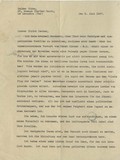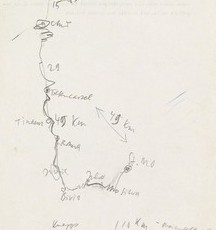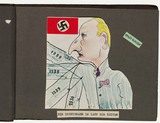Ulrich Becher: Der Hampelmann [The Jumping Jack], c. 1934
Ulrich Becher: Der Hampelmann [The Jumping Jack], c. 1934
Regine Frischherz was the golden-haired daughter of the farmer, artist and noted marksman Martin Frischherz von Steinen and Kumera Rickenbach from Arth am See. In 1899, this Frischherz was appointed the third lessee of the ‘Rütli’ (the lease was always given to a son of the forest canton); he was quite a progressive man for his time, who with his father Othmar Schoecks founded the first secular school in the original cantons, namely in Brunnen; he was an authority on the Czarist empire, whither he had escaped from his father’s village of cherry farmers during his adolescence; he was also a great supporter of Pestalozzi, besides being an original painter who had turned away from the art nouveau style so popular at the time and whose frescos adorned the numerous chapels, council chambers and inns of the old cantons, their conscious simplicity reminiscent of the tax collector Rousseau, the first exponent of the ‘primitive’ style. (ed. trans.)
Excerpt from Ulrich Becher’s fragmentary novel Der Hampelmann [The Jumping Jack], c. 1934
From 1934, by which time he was already in exile, Ulrich Becher used this gold-ochre Biedermeier book with the wine-red linen binding to make the first handwritten notes on his mother’s extensive family history. He gave these drafts the working title Hampelmann. Fahrt, Freud und Leid eines jungen Kerls in Europa (The Jumping Jack. Travels, Joys and Sorrows of a Young Man in Europe). The title refers to Becher’s legendary Swiss grandfather Martin Ulrich and his adventurous life. His years as an emigrant in Russia, where he had made his way on foot and founded a painter’s studio, were followed by a temporary lease of the legendary Rütli meadow, the opening of a Pestalozzi school in the canton Schwyz, and a failed attempt to emigrate to New York in 1902, before he finally settled in Reinickendorf, Berlin, where he worked as a factory inspector. This grandfather, an artistic man who inclined towards political pacifism and who played an active part in the November Revolution, was for Becher an important, inspiring attachment figure to whom he intended to pay literary tribute in Hampelmann. He worked on this novel until his flight from Switzerland to Brazil in 1941, when parts of the manuscript are said to have been lost; the novel never progressed beyond this fragment. The bundles of text it contains deal first and foremost with the career of Becher’s mother, Martin Ulrich’s daughter Elise Becher-Ulrich, who trained as a piano teacher in Lausanne, Strasbourg and Berlin. Individual extracts from the fragment were in fact published in various newspapers (Schweizervision, Das Blauwolkenhaus), but the vast majority is still waiting to be discovered.

![Biedermeier book containing the manuscript of Der Hampelmann [The Jumping Jack] Biedermeier book containing the manuscript of Der Hampelmann [The Jumping Jack]](/KIE/Content/EN/SpecialExhibitions/UlrichBecher-en/Images/Objects/hampelmann.jpg?__blob=normal&v=3)





